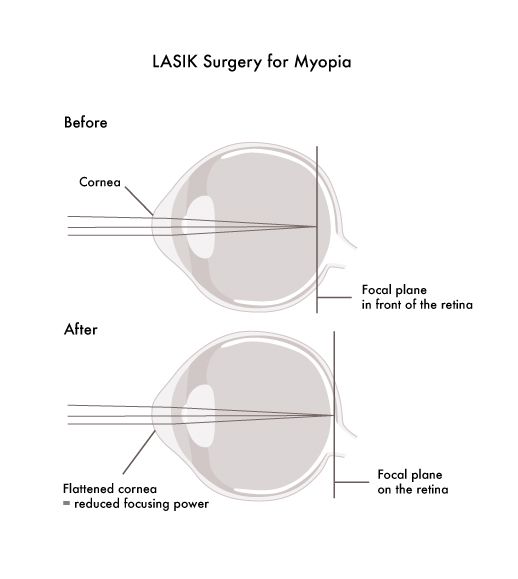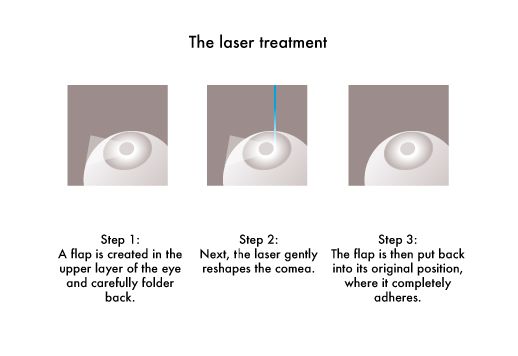Common Vision Problems
LASIK InformationLASIK (laser in situ keratomileusis) is an outpatient refractive surgery procedure used to treat nearsightedness, farsightedness, and astigmatism. With LASIK, the ophthalmologist (your eye doctor) uses a laser to create a thin flap in the cornea—the clear, round dome at the front of the eye. The surgeon then folds back the flap and reshapes the cornea using a preprogrammed excimer laser. Finally the flap is laid back in the original position and recovers in place. The procedure is done to improve the way the eye focuses light rays onto the retina at the back of the eye, thus allowing for better vision. There are many misconceptions that Lasik is a cure for myopia (nearsightedness). The fact is, Lasik is just a refractive procedure which is used to remove the need for glasses wearing and contact lenses use. Sadly but true, the internal structure of the eye remains unchanged. That is to say, a thinned-out retina from high myopia will remain just as thin after Lasik surgery. Thus, plainly enough, the risks of any eye conditions associated with myopia will still remain, even after surgery. And the same theory applies to presbyopia (farsightedness). To further elaborate, though not at all pleasing, if you are nearsighted, after Lasik you may still develop presbyopia (farsightedness) as you age, and you will need reading glasses to correct your vision; it may also mean you will need reading glasses at an earlier age than had you not had Lasik. The above fact might not sound encouraging, but do bear in mind Lasik is a refractive surgery procedure and any surgery procedures have risks and shortcomings. An alternative way to look at it is that it edits your life with a carefully done and highly-advanced procedure to bring you back the long gone vision acuity. However, not everyone is suitable for Lasik, check out the list below: |
 |
PERSON WHO MAY BE SUITABLE FOR LASIK:
- Aged 18 or above to ensure a stable prescription
- Common eye health issues such as short-sightedness, long-sightedness, and astigmatism
- People who cannot/refuse to wear eyeglasses or contact lens
- In general good health
OPERATION FLOW
|
 |
The patient should plan to have someone take/drive him or her back home and rest for the rest of the day. Remember avoid rubbing the eyes. To help protect the cornea as it heals, the surgeon may place a transparent shield over the eye(s) to protect against accidental bumps and to remind the patient not to rub the eye(s). The patient may need to wear the shield only when sleeping. The surgeon will provide eyedrops to help the eye heal and relieve dryness.
ADVANTAGES OF TAKING LASIK EYE SURGERY
- LASIK corrects vision with a success rate of 96%.
- The whole procedure takes approximately 5 to 10 minutes to perform and is very effective.
- LASIK is able to accurately correct most levels of myopia (nearsightedness), hyperopia (farsightedness), and astigmatism.
- Because the laser is guided by a computer, it is very precise and results are very accurate.
- Lasik is associated with very little pain.
- Vision is corrected almost immediately or by the day after the procedure.
- Recovery is quick and usually no bandages or stitches are required.
- Adjustments can be made years after the procedure to further correct vision.
- After Lasik, most patients no longer need corrective eyewear.
DISADVANTAGES OF TAKING LASIK EYE SURGERY
- Presbyopia. LASIK can eliminate the need for prescription eyeglasses but presbyopia still develops in 40s or 50s and reading glasses are needed.
- For patients with high myopia, perfect vision after Lasik might not be possible which means there's still the need for corrective lenses.
- Sensitivity to light. A small portion of people may experience in this situation. It leads to stress, insomnia and minor health problem.
- Dry Eye. The most common complication of Lasik. As the laser 'cuts' the cornea, which means corneal nerves which are responsible for tear production may be reduced.
- Lasik could make some aspects of your vision worse, including hazy or blurry vision; difficulty with night vision and/or driving at night; scratchiness; glare, halos or starbursts around lights; discomfort or pain; or small pink or red patches on the white of the eye.
- In rare circumstances, Lasik can make vision worse and not correctable with regular glasses or contact lenses.
- Changes made to the cornea cannot be reversed after the procedure. Corrections can only be made by additional Lasik surgeries.
- Problems may occur when the doctor cuts the flap during the procedure, which can permanently affect vision.




